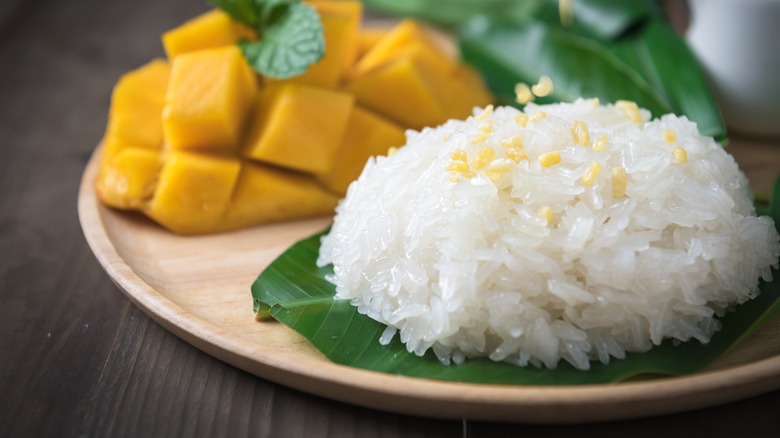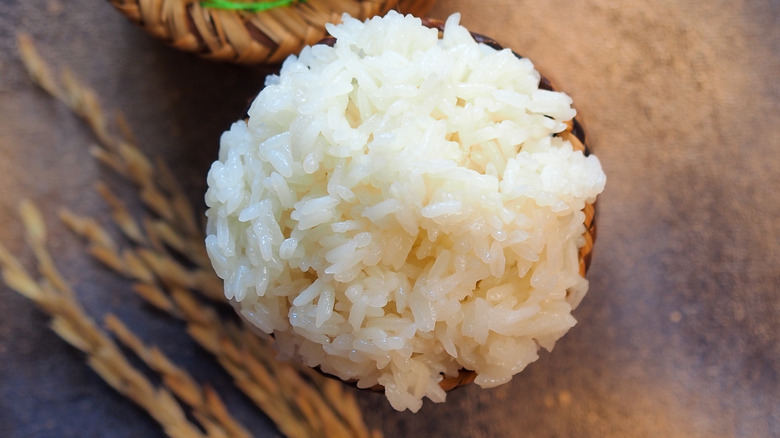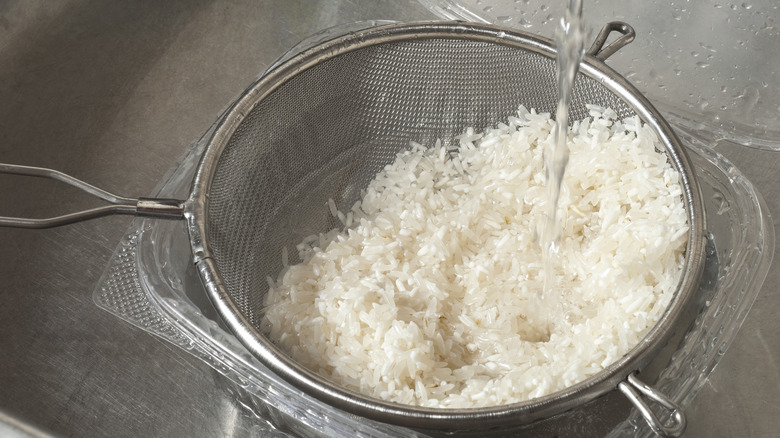Here's How To Make Sure Your Sticky Rice Doesn't Get Too Sticky
What makes sticky rice (also known as glutinous rice) one of the best side dishes is that it has just enough flavor to give you a sweet taste but not so much sweetness that it will overwhelm the taste of any flavorful dish the rice accompanies. That complementary flavor is why it's so delicious to eat with rich-tasting dishes such as savory Japanese curry, salty beef jerky, sweet mango, and sour and spicy chicken pad Thai. The glue-like texture of sticky rice that makes the grains gummy is also what makes it so appetizing. However, you don't want your rice to be so claggy that the grains turn into one huge clump of rice. If you're making it at home and trying to achieve the optimal texture of restaurant-style sticky rice, then there's one critical step you must take when preparing your rice to ensure it isn't too glutinous after you cook it.
Conventional sticky rice recipes will call for you to first soak the grains in water for several hours or even overnight. After you have soaked the rice, you must rinse it to remove the excess starch that makes glutinous rice so sticky. This will ensure that the grains separate just enough while cooking so that your final dish will have a smooth, sticky consistency but not get too clumpy.
It's a type of starch that makes glutinous rice sticky
Amylose and amylopectin are the two starches that you'll find in all types of rice. The amount of these two starches in the grains accounts for the ultimate texture of the rice once it's cooked. When you cook rice, these starch molecules react differently as the rice absorbs the liquid as you cook it. Amylose molecules do not gelatinize when cooked. If you cook rice that has a high amylose content, the rice grains will fully disconnect and remain untethered after they are cooked. In contrast, amylopectin molecules make rice grains stickier when the rice is cooked.
Glutinous rice becomes sticky after you cook it due to the near lack of amylose starch and the high amount of amylopectin starch on the rice grain. By rinsing glutinous rice after soaking it, you help shed the extra starch on the grains so they can stay separate as they cook. This will make your sticky rice just sticky enough to enjoy its distinct texture. Just be sure to rinse your glutinous rice properly to get the best textural results.
How to rinse sticky rice
You can rinse glutinous rice in several steps. After you've soaked your rice for several hours, pour the water out through a fine-mesh strainer to catch the rice. Then, place the strainer of rice over the bowl and fill it with water until all the rice is submerged. If necessary, you can use a simple spoon hack to hold the strainer in place. Next, wash your hands to make sure they are clean, then stir the rice in the strainer with your hands to remove the excess starch from the grains.
As the starch dislodges from the rice, the water in the bowl should become cloudy. Remove the strainer of rice from the bowl, leaving the excess starch in the water left behind. Pour out the starchy water from the bowl and repeat the process. You should rinse the rice at least three times (or until the water is clear) to sufficiently remove the excess starch to keep it from getting too clumpy while it cooks. While there are many simple rice tricks you can use to improve your rice dishes, rinsing it will make your sticky rice just sticky enough for you to enjoy.


